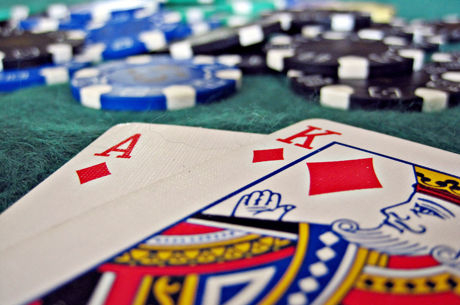Stud Strategy: Starting Hands Part IV - 3-Flushes

Ashley Adams has been playing poker since he learned it, literally, at his grandfather's knee 42 years ago. He's been a winning casino poker player for the past 11 years, playing primarily at Foxwoods Resort Casino but also in poker rooms all over the world. He has won at ring games and tournaments, at Stud, Stud8 and Hold Em, limit and no limit. He is the author of Winning 7-card Stud (Kensington, 2003) and over 100 articles about poker. He is due to publish Winning Baby No Limit Hold Em in 2006 and has recently been working with numerous charities on fundraising poker tournaments.
You do not have to limit yourself to playing pairs when you start out in a 7-Card Stud hand. Three cards of the same suit, which I call 3-Flushes, are also playable. But their play is neither automatic nor simple.
Many beginning players, holding any three suited cards, will simply call any bet on Third Street. This is surely a mistake. You need to be more discriminating. There are generally four considerations a successful player needs to keep in mind before deciding to play.
First, you need to see if your suit is live. By live I mean whether the cards that will make your Flush are yet to be exposed. My general rule of thumb is that if I see more than two of my suit out in front of other players on the deal I do not play the 3-Flush. I just don't play. No further thought is necessary. Just fold.
But that doesn't mean that I can call any bet if there are two or fewer of my suit exposed. There are two other factors I need to consider: do I have at least one high card and will I be in the hand for only one bet.
I want at least one Premium card, preferably a King or an Ace, among my three suited cards. That's because I want two ways to win the hand. I want to be able to win by developing into a Flush. But I'd also like the backup possibility of improving to a Premium Pair by pairing my high card. If I start with 3h 5h 8h my hand really has no future if I don't get another heart on Fourth Street. But if I start with Kh 5h 8h I can improve with any of the ten other hearts or with the three other Kings. Having the King means that the good Fourth Street cards have just increased 30%!
Of course, I want to look around and make sure that this high card is live as well. So if two of my hearts are out and a King is out, then this hand is barely playable. I want a completely live high card and no more than two of my suit out.
The third consideration is the amount of money I'm committing to the hand on Third Street. I don't want to commit more than one full bet with my 3-Flush. Sometimes that's easy to know. Say, for example, a player with a Queen in early position completes the bet to $10 in a $10/20 game and then a player with an Ace re-raises to $20.00 and the action comes to you. You fold your 3-Flush no matter what you're holding. It's at least two bets to you and the first bettor still may raise. You don't want to be in a hand like that, committing at least two bets on a 3-Flush - even with a high card and live suited cards. Other times you have to infer what the eventual bet may be to you before you commit yourself to the hand. For example, imagine that you are in early position - second after the bring-in. The one player who acts before you, with a low card, raises the bet. You see a smattering of high cards after you, two held by very aggressive players. You can infer that the pot is likely to be raised again. You don't' have the luxury of finding that out before you call your bet but you can make an educated guess that one of those high cards either has a Premium pair or will try to represent it by raising. Once again, even if your suit is live and you have a good high card in the mix, you should fold.
On the other hand, if you're in late position and everyone has checked and a King in front of you raises and your cards are live and you have an Ace among your suited cards, well then go ahead and call the raise, since it's unlikely that someone who has checked initially will raise the raiser. So you'll probably be in a pot that is only raised once.
The final consideration is how many players will be in the hand as it progresses. What you want to avoid with your 3-Flush is a heads-up hand. You want pots that will pay you well for your thin drawing possibilities. The odds certainly do not favor your completion of the flush - even if you start with three suited cards (You have roughly one chance in eight to complete your flush if your cards are live). So you want to make sure that there will be more than one person in the pot, building the pot, as you attempt to draw your Flush. On the other hand, if it's pretty clear that the hand will be heads up until the River then you don't want to be in it.
Say, for example, an Ace raises early on and everyone folds to you, in late position. You have (Kh-3h)9h. Only the bring in, with a 2d remains after you. You must fold this hand even if your hearts are live. It's highly unlikely that you'll have a multi-way pot. And even if you pair your King you are likely to be an underdog to the player who raised with the Ace and is likely to have a pair of Aces. So fold early on.
Some players like to raise when they hold a 3-Flush. They do it automatically, just as if they had a Premium Pair. This, in my view, is a large mistake. There are situations when a raise may make sense, but in general, you want to enter the hand as cheaply as possible. You have a drawing hand, not a made hand. You want to get the best possible ratio between the eventual pot odds and the cost of the hand. By raising you are usually increasing the cost for you to draw your hand without sufficiently increasing the size of the pot you will eventually win if you win it. Your raise will usually serve to limit the field, something you don't want to do. There are exceptions to this - times when you can raise with a 3-Flush - but I'll cover them later when I address more advanced stud strategy.
Please visit our online poker room directory to see the best bonuses on the web!








